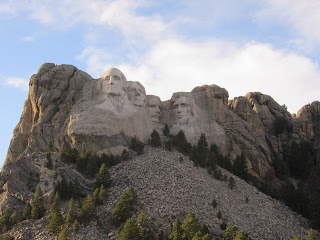Mount Rushmore National Memorial
Most stores and hotels were "closed for the season" so the drive through Keystone (the closest town) felt deserted, but just imagine the hustle and bustle that can be found there during the summer. (Wayne is particularly interested in checking out Rattlesnake Jake's!)
There is no entrance fee to the memorial, but there is a parking fee. There's a large parking structure geared for the summer crowds, which also felt deserted, but after parking we headed up the walkway to the gift shop and information center.
I guess my expectations for the "parade of flags" were too high, because it felt a bit underwhelming. However, for most others I suspect it's a beautiful display.
After watching the 15-minute video in the visitor's center (different from the information center, and underneath the main viewing patio), we headed out on the short Presidential Trail (which is all paved, although not wheelchair-friendly due to the stairs).

The sculptor's studio was also closed for the season, but we did learn that Gutzon Borglum was the sculptor for Stone Mountain in Georgia, which gave him experience he used in South Dakota. You can read about our visit to that monument here.
We really enjoyed reading this prize-winning essay - a 300 word history of the United States. You can read it yourself here (and also below).
Someday we'll be back to South Dakota to explore Wind Cave National Park. Maybe we'll stop again at Mount Rushmore. Maybe not. But at least we have some wonderful memories of this year's visit.
The Essay:
Almighty God, from this pulpit of stone the American people render thanksgiving and praise for the new era of civilization brought forth upon this continent. Centuries of tyrannical oppression sent to these shores, God-fearing men to seek in freedom the guidance of the benevolent hand in the progress toward wisdom, goodness toward men, and piety toward God.
1776
Consequently, on July 4, 1776, our forefathers promulgated a principle never before successfully asserted, that life, liberty, equality, and pursuit of happiness were the birthrights of all mankind. In this declaration of independence beat a heart for all humanity. It declared this country free from British rule and announced the inalienable sovereignty of the people. Freedom’s soldiers victoriously consecrated this land with their life’s blood to be free forever more.
1787
Then, in 1787 for the first time a government was formed that derived its just powers from the consent of the governed. General Washington and representatives from the 13 states formed this sacred Constitution, which embodies our faith in God and in mankind by giving equal participation in government to all citizens, distributing the powers of governing, three fold securing freedoms of speech and of the press, establishing the right to worship the Infinite according to conscience, and assuring this nation’s general welfare against an embattled world. This chart of national guidance has for more than 150 years weathered the ravages of time. Its supreme trial came under the pressure of Civil War, 1861-65. The deadly doctrines of secession and slavery were then purged away in blood. The seal of the Union’s finality set by President Lincoln, was accomplished like all our triumphs of law and humanity, through the wisdom and the power of an honest, Christian heart.
Far-sighted American statesmanship acquired by treaties, vast wilderness territories, where progressive, adventurous Americans spread civilization and Christianity.
1803
In 1803, Louisiana was purchased from France. This acquisition extended from the Mississippi River, across the fertile prairie to the Rocky Mountains, and paved the way for America's preeminence among the nations.
1819
In 1819, the picturesque Florida peninsula was ceded as payment of Spanish obligations due to Americans.
1845
In 1845, Texas, having patterned American democracy during the ten years of freedom from Mexican rule, accepted the invitation to join the sisterhood of states. In 1846, the Oregon country was peacefully apportioned by the 49th parallel as the compromised international boundary of the two English-speaking nations.
1848
In 1848, California and territory likewise rich in natural resources was acquired as the consequence of an inevitable conflict with Mexico. In spirit of mutual concession, the United States granted additional indemnities for the adjustment of the international boundary, extending from the Rio Grande to the Gulf of California.
1850
In 1850, Texas willingly ceded the disputed Rio Grande region, thus ending the dramatic acquisition of the west.
1867
In 1867, Alaska was purchased from Russia.
1904
In 1904, the Panama Canal Zone was acquired for our people to build a navigable highway enabling the world's people to share the fruits of the earth and human industry.
Now, these eras are welded into a nation possessing unity, liberty, power, integrity and faith in God, with responsible development of character and devoted to the performance of humanitarian duty.
Holding no fear of the economic and political, chaotic clouds hovering over the earth, the consecrated Americans dedicate this nation before God, to exalt righteousness and to maintain mankind's constituted liberties so long as the earth shall endure.
William Andrew Burkett


.JPG)













Comments